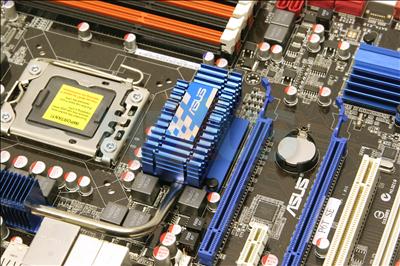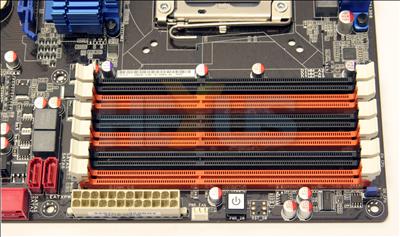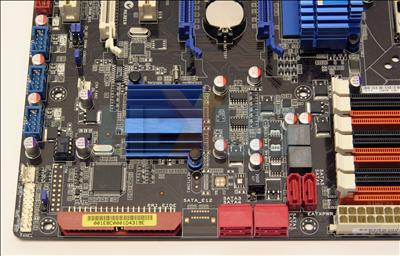Layout, and something missing?
ASUS lists no fewer than 12 X58 chipset-based boards in its catalogue. Prices range from £140 through to £340 for the supercomputer-oriented P6T7 WS.The cheapest of the bunch is the P6T SE. On first glance it doesn't look much different to the more expensive P6T. Dig a little deeper and the most obvious differences are the removal of the onboard reset switch, two of the SATA ports, as well as the little-used floppy header, which was awkwardly placed in the corner, anyway.
Layout is generally pretty good when one considers that it houses a trio of PCIe x16 lanes and a full complement of DDR3 slots.
Keeping costs in check, the heatpipe cooling only extends to the X58 IOH and the hot-running components on the other side of the CPU socket. Installing a standard cooler is a cinch; there's enough clearance on all sides. The two sets of holes mean that you can use either LGA1366 coolers (preferred) or an LGA775 model.
Somewhat strangely, the CPU fan header is located right by the primary x16 PCIe slot, and you may well miss it on first perusal of the board.
We reckon that it only makes sense if X58 boards have six DDR3 slots. ASUS follows this advice. The accompanying manual spells out memory kits that are qualified to run at certain speeds. DDR3 2,000MHz is supported on four modules, but the capacity limit of just 2GB and dual-channel operation makes it simply a tickbox rather than pragmatic feature.
Generally speaking, 6GB+ kits (3 x 2GB) are officially supported at DDR3-1,600MHz speeds, together with XMP usage. The power button is a boon if, like us, you're constantly fiddling with BIOS settings in an open-air testing environment.
Six SATA ports are bolstered by a JMicron controller that provides eSATA support on the rear and a solitary PATA controller for ye olde drives. The angled nature of both sets of connectors means that extra-long graphics cards won't foul access.
A triumvirate of x16 PCIe slots would open up the way for an eclectic multi-card setup. You'd be correct insofar as AMD cards are concerned, as the P6T SE supports three-way CrossFire. Inexplicably, the board doesn't have NVIDIA's SLI certification, which is a major faux-pas. The next model up, P6T, is the one to go for if SLI is a priority.
In terms of layout, swapping the PCIe x1 slot's position for the PCIc's would make sense, we feel. This isn't the deal it could be because the x16 PCIe slots can be used to house x1 and x4 cards.
Notice the gaggle of jumpers by the bottommost PCIc slot? Moving them to active, which is the default state, enables you to gain access to the upper levels for Vcore, DRAM voltage and QPI voltages in the BIOS.
Coaxial and optical S/PDIF connectors get a thumbs-up from us. eSATA, FireWire, USB 2.0 are all standard fare for X58, and we'd probably chop the legacy PS/2 ports and add in a further two USB 2.0s.
The P6T SE's layout is above average. The various multi-wire connectors are at the edge of the board and most ports/sockets are easy enough to get to. It's just a shame about the lack of SLI support.








